Related Research Articles
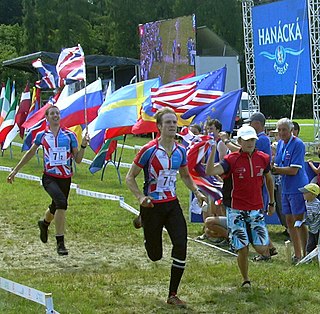
A relay race is a racing competition where members of a team take turns completing parts of racecourse or performing a certain action. Relay races take the form of professional races and amateur games. Relay races are common in running, orienteering, swimming, cross-country skiing, biathlon, or ice skating. In the Olympic Games, there are several types of relay races that are part of track and field. Relay race, also called Relay, is a track-and-field sport consisting of a set number of stages (legs), usually four, each leg run by different members of a team. The runner finishing one leg is usually required to pass the next runner a stick-like object known as a "baton" while both are running in a marked exchange zone. In most relays, team members cover equal distances: Olympic events for both men and women are the 400-metre and 1,600-metre relays. Some non-Olympic relays are held at distances of 800 m, 3,200 m, and 6,000 m. In the less frequently run medley relays, however, the athletes cover different distances in a prescribed order—as in a sprint medley of 200, 200, 400, 800 metres or a distance medley of 1,200, 400, 800, 1,600 metres.

Cross country running is a sport in which teams and individuals run a race on open-air courses over natural terrain such as dirt or grass. The course, typically 3–12 kilometres (1.9–7.5 mi) long, may include surfaces of grass and earth, pass through woodlands and open country, and include hills, flat ground and sometimes gravel road and minor obstacles. It is both an individual and a team sport; runners are judged on individual times and teams by a points-scoring method. Both men and women of all ages compete in cross country, which usually takes place during autumn and winter, and can include weather conditions of rain, sleet, snow or hail, and a wide range of temperatures.

Trail running is a type of running that takes place on outdoor trails, often in mountainous terrain, and often includes significant ascents and descents. Trail running is overseen by the International Trail Running Association (ITRA) and includes longer races.
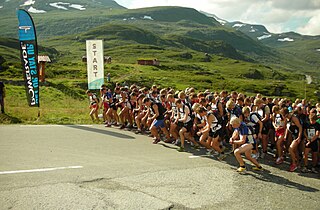
Fell running, also sometimes known as hill running, is the sport of running and racing, off-road, over upland country where the gradient climbed is a significant component of the difficulty. The name arises from the origins of the English sport on the fells of northern Britain, especially those in the Lake District. It has elements of trail running, cross country and mountain running, but is also distinct from those disciplines.
The Dipsea Race is a trail running event in California, United States. It is the oldest cross-country trail running event and one of the oldest foot races of any kind in the United States. The 7.5 mile (12 km) long Dipsea Race has been held annually almost every year since November 19, 1905, starting in Mill Valley, and finishing at Stinson Beach, in Marin County. Since 1983, the race has been held on the second Sunday in June. The Dipsea celebrated its 111th running on Sunday, June 12, 2022.
The Pentland Hills are a range of hills southwest of Edinburgh, Scotland. The range is around twenty miles in length, and runs southwest from Edinburgh towards Biggar and the upper Clydesdale.
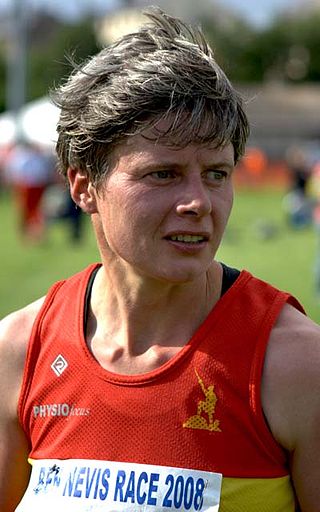
Angela Mudge is a Scottish champion hill runner and skyrunner. Despite being born with birth defects in both legs, and finding track athletics not to her liking, she discovered her sport while a postgraduate student in Scotland in the mid-1990s, and developed rapidly.
The Welsh 1000m Peaks Race takes place on the first Saturday in June each year. The 32 km route is also known as the Snowdonia Summits Marathon as competitors have to reach the top of all the 1000 metre peaks in Wales.
Colin Kerr Donnelly is a Scottish runner who was the British fell running champion three times and finished second in the World Mountain Running Trophy.
John Richard Wild is a male English former runner who competed in cross country, fell running, and the 3000m steeplechase.
Gavin Bland is a British fell runner who was a British and English champion and represented his country at the World Mountain Running Trophy.

The Borrowdale Fell Race is an annual fell race held in August, starting and finishing in Rosthwaite. It is considered to be one of the "classic" Lakeland races and the route initially heads over Bessyboot before climbing England's highest summit, Scafell Pike. Great Gable is then scaled before a descent to Honister Pass and the final climb up Dale Head. The distance is approximately 17 miles and the route has around 6,500 feet of ascent.
The Wasdale Fell Race is an annual Lake District fell race held in July, starting and finishing at Brackenclose in Wasdale. The course is approximately twenty-one miles long with around 9,000 feet of ascent and takes in checkpoints at Whin Rigg, Seatallan, Pillar, Great Gable, Esk Hause shelter, Scafell Pike and Lingmell nose wall. The route between Pillar and Lingmell is very rough, with steep technical ground and boulder fields. Among long fell races, Wasdale has one of the highest ratios of feet of ascent per mile, and it is often considered to be the toughest of the British races.

The Langdale Horseshoe is an annual Lake District fell race that starts and finishes at the Old Dungeon Ghyll. The course climbs to Stickle Tarn before heading to Thunacar Knott, Esk Hause shelter, Bowfell, Crinkle Crags and Pike of Blisco. The route is approximately 21 kilometres (13 mi) in length with 1,450 metres (4,760 ft) of ascent. It includes much rough and rocky ground. On the descent from Crinkle Crags, many runners negotiate the Bad Step, although it can be avoided depending on route choice. The race often presents navigational difficulties, especially in poor visibility.
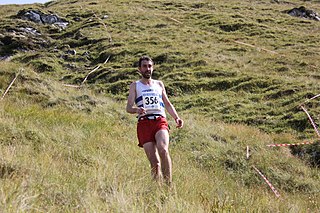
Finlay Wild is a Scottish runner and mountaineer who has been a British fell running champion. He has won the Ben Nevis Race twelve times.
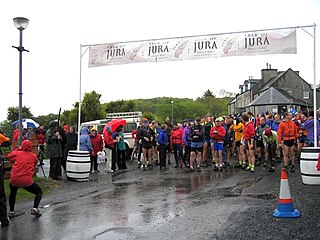
The Isle of Jura Fell Race is an annual fell race held in May, starting and finishing at Craighouse on the Scottish island of Jura. The course loops west and north over several hills including the Paps of Jura. After the last climb to Corra Bheinn, a boggy descent takes the runners down to the tarmac coastal road which is followed for the final three miles to the finish. The route is approximately 17 miles (27 km) in length, with around 2,350 metres (7,710 ft) of ascent. As well as being known for the very difficult rocky and boggy terrain involved, the race is notable for its remoteness. The journey to the start of the race typically involves a ferry journey from the Scottish mainland to Islay, followed by another ferry to Jura and then several miles by bicycle, by bus or on foot to Craighouse.

The Ennerdale Horseshoe Fell Race is an annual Lake District fell race held in June, starting and finishing at the Scout Camp near Ennerdale Water. The route is approximately 36.8 kilometres (22.9 mi) in length with 2,290 metres (7,510 ft) of ascent and takes in checkpoints at Great Borne, Red Pike, Blackbeck Tarn, Green Gable, Kirk Fell, Pillar, Haycock, Iron Crag and Crag Fell.
The Sedbergh Hills Fell Race is an annual fell running race in Cumbria, England. The race starts and finishes in Sedbergh and has a distance of approximately 22.5km and contains 1830m of ascent. It is usually run in August. The inaugural event was held in 1979. The ladies' race was held over a shorter course that year, but subsequently the women ran the same route as the men. In its early years, the race was organised by Mike Walford on behalf of Kendal Athletic Club.
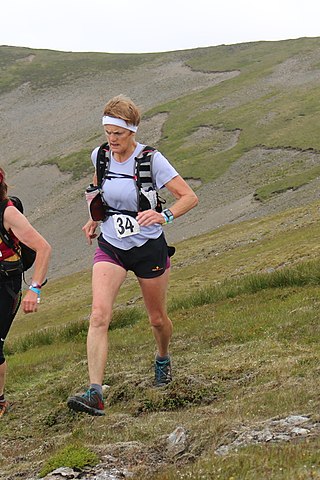
Beverley Redfern is a British mountain runner who won the 1990 World Mountain Running Championships.
The Coniston Fell Race is an annual Lake District fell race held in April or May, starting and finishing in the village of Coniston. The route is approximately 14 kilometres (8.7 mi) in length with 1,065 metres (3,494 ft) of ascent and takes in checkpoints on the summits of Wetherlam, Swirl How and the Old Man of Coniston.
References
- ↑ Angela Mudge, World’s Ultimate Running Races (Glasgow, 2011), 49; "Carnethy 5". Carnethy Hill Running Club. 19 December 2014. Retrieved 28 September 2016.
- ↑ Steve Chilton, It's a Hill, Get Over It (Dingwall, 2013), 77–78.
- ↑ Bill Smith, Stud Marks on the Summits (Preston, 1985), 196–99 Archived 23 December 2016 at the Wayback Machine ; Carnethy Hill Runners: Carnethy 5 Results Summary.
- ↑ The Fell Runner, Summer 1986, 12, 71.
- ↑ The Fell Runner, Jun 1990, 20–21.
- ↑ Scottish Hill Racing: Carnethy 5 Hill Race; Inov-8: Orlando starts 2014 season with a bang!
- ↑ Carnethy Hill Running Club: Runners who have Completed 21 or More Carnethy Hill Races.
- ↑ Carnethy Hill Running Club: Scald Law Junior Hill Race.
- ↑ Carnethy Hill Runners: Carnethy 5 Results Summary; Bill Smith, Stud Marks on the Summits (Preston, 1985), 196–99 Archived 23 December 2016 at the Wayback Machine ; The Fell Runner, Jun 1990, 20–21.